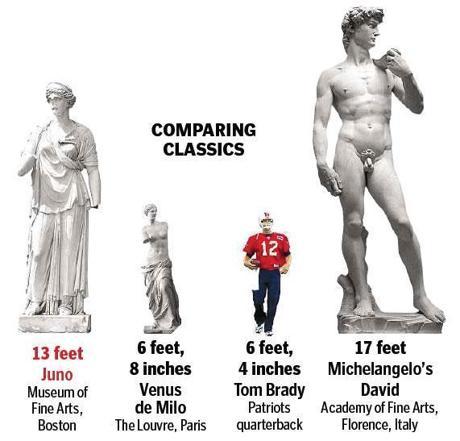THE PROGRESS OF JUNO
A large, 2nd-century sculpture of a goddess, believed to be Juno, was acquired last year by the Museum of Fine Arts, Boston, following its discovery in a Boston suburb. Unveiled last month, the statue is on display while conservators work around it, enabling visitors to view the process of restoration
Christine Kondoleon & Susanne Gänsicke, Tuesday, 1st May 2012
The discovery of a large antique sculpture in a city suburb has to be a rare occasion. But that is exactly what happened when the Museum of Fine Arts (MFA) discovered a 2nd-century Roman statue, which had stood little noticed on a grand Boston estate mere miles from the museum. The MFA acquired the sculpture from the family, who had owned the work for 100 years, naming her Juno because she wears a crescent diadem and her hair in a rolled chignon in the manner of the goddess (Fig. 1). At 13 feet (the figure stands on a pedestal about a foot high) and weighing about 13,000 pounds, the statue made an impressive axial focal point in a celebrated Italianate garden by Charles Adams Platt (1861–1933) on the Brookline estate named Faulkner Farm (later known as the Brandegee Estate)....
The statue’s American owner was Mary Pratt Sprague, granddaughter of the shipping and railroad magnate, William Fletcher Weld. Together with her first husband, Charles F. Sprague, she undertook an ambitious building campaign in Brookline. The estate’s gardens were legendary and especially noted for their inspiration from Italian Renaissance villa gardens. The house held many fine paintings, drawings, and other works, while antiquities were largely used as garden ornaments. Mary was an ardent art collector and seems to have held as both a model and rival her Brookline neighbour, Isabella Stewart Gardner (whose legacy is discussed in the January 2012 issue of Apollo). Both women used Richard Norton (1872–1918) as an art consultant; he was based in Rome as he was the first director of the American School of Classical Studies at Rome (which merged with the current American Academy in 1913). Many of the earliest objects of Greek and Roman antiquity came to Boston through the agency of Norton (such as this 2nd-century sculpture of a priestess burning incense; Fig. 2), but none is as spectacular as Juno. In an 1897 letter to the noted Boston architect Thomas A. Fox, Norton urges him to persuade the Spragues to acquire the ‘big statue’, because ‘this is really a chance such as hardly ever occurs.’ He goes on: ‘…and how lucky is America to have people like the Spragues who know enough to get really fine things,’ adding: ‘I am staking my whole reputation on this one thing because it will become well known at once.’.....
The statue’s earlier history takes us back to the Ludovisi collection, one of the most famous private collections of ancient sculpture in Rome. Formed by Cardinal Ludovico Ludovisi (1595–1632), the cardinal-nephew of Pope Gregory XV, the Ludovisi estate was located on the grounds of the ancient Gardens of Sallust (Horti Sallustiani) and covered a vast area inside the Porta Pinciana. The Ludovisi set about amassing their collection quickly from many sources and in competition with the neighbouring Villa Borghese. Many sculptures are thought to have been found on the Villa Ludovisi’s own archaeologically rich land, but the inventories do not indicate findspots. Most significantly, Juno is attested from 1633 onwards in the inventories of the Villa Ludovisi. An 1885 photograph, taken by Prince Rodolfo Boncompagni Ludovisi just before the villa and gardens were sold and broken up, shows the colossal statue at the end of the great avenue of cypresses (Fig. 3). The photograph reveals the sculpture with hands (probably added afterwards given the visible breaks), and a head with its face intact. Today part of the mouth and nose are missing due to an accident on the Brandegee Estate.....
Extensive modifications of nearby galleries included not only the de-installation of works of art, but also the removal of display cases and even a wall to allow the physical manoeuvring of the sculpture and the temporary installation of industrial moving equipment. At last, once the metal cage and all other additional support materials had been removed, the sculpture acquired a commanding position in the Behrakis Gallery.
The head is temporarily mounted onto a separate pedestal next to the sculpture (Fig. 9), while conservation continues in the gallery. Treatment will address surface cleaning, consolidation of cracks, and, eventually, reattachment of the head, as well as other aesthetic issues of loss compensation. Stable isotope analysis may lead to detailed identification of the type of marble and the original quarrying sites.
As it remains unknown when the head was attached to the sculpture, it is hoped that further analysis of repair materials will lead to new insights. Studies will focus on the composition of the iron pin and what is believed to be grout used to set this pin originally; additionally, tool marks on the edges of the neck, head and, the torso will be investigated.
Christine Kondoleon is the George and Margo Behrakis Senior Curator of Greek and Roman Art at the Museum of Fine Arts, Boston.
Susanne Gänsicke is Conservator of Objects in the Department of Conservation and Collections Management at the Museum of Fine Arts, Boston.
Juno is on display at the Museum of Fine Arts, Boston. The museum’s website enables online visitors to follow the progress of the conservations efforts. Go to:
www.mfa.org/collections/conservation/conservationinaction_juno







